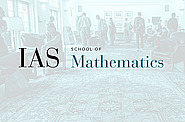Events and Activities
Explore current and upcoming events and activities happening at the Institute for Advanced Study.
Apr
29
2024
Computer Science/Discrete Mathematics Seminar I
Lower Bounds for Set-Multilinear Branching Programs
Shubhangi Saraf
11:00am|Simonyi 101 and Remote Access
Apr
29
2024
Princeton University Galread [Galactic/Extragalactic Reading Group]
TBA
11:00am|Zoom and Peyton Hall, Grand Central
Apr
29
2024
Princeton University Extrasolar Planet Discussion Group
TBA
12:00pm|Zoom and Peyton Dome Rm, Princeton University
Apr
29
2024
Institute for Advanced Study/Princeton University Early Universe/Cosmology Lunch Discussion
DESI 2024 Y1 BAO results in-depth, and an accompanying discussion.
12:30pm|Peyton Hall, Grand Central
Apr
29
2024
Apr
29
2024
Joint IAS/Princeton Arithmetic Geometry Seminar
Microlocal Sheaves and Affine Springer Fibers
Pablo Boixeda Alvarez
3:30pm|Fine 322, Princeton University
Apr
30
2024
Computer Science/Discrete Mathematics Seminar II
Incidence Bounds via Extremal Graph Theory
Istvan Tomon
10:30am|Simonyi Hall 101 and Remote Access
Apr
30
2024
Institute for Advanced Study / Princeton University Bahcall Lunch
12:30pm|Lewis Library, Princeton University
Apr
30
2024
May
02
2024
Institute for Advanced Study Astrophysics Seminar
Testing Galaxy Formation Models with Large-scale Surveys of the Milky Way Stellar Halo
Emily Cunningham
11:00am|Bloomberg Lecture Hall

